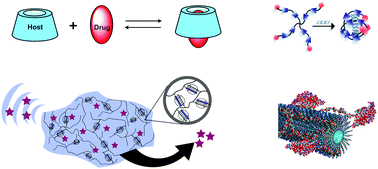当前位置:
X-MOL 学术
›
Chem. Soc. Rev.
›
论文详情
Our official English website, www.x-mol.net, welcomes your feedback! (Note: you will need to create a separate account there.)
Drug delivery by supramolecular design
Chemical Society Reviews ( IF 46.2 ) Pub Date : 2017-08-22 00:00:00 , DOI: 10.1039/c7cs00391a Matthew J. Webber 1, 2, 3, 4, 5 , Robert Langer 4, 6, 7, 8, 9
Chemical Society Reviews ( IF 46.2 ) Pub Date : 2017-08-22 00:00:00 , DOI: 10.1039/c7cs00391a Matthew J. Webber 1, 2, 3, 4, 5 , Robert Langer 4, 6, 7, 8, 9
Affiliation

|
The rational design of drug delivery approaches leveraging supramolecular chemistry (i.e., “chemistry beyond the molecule”) has garnered significant interest in recent years toward improving therapeutics. By using specific, dynamic, and tunable non-covalent interactions, engineered approaches to drug delivery can be realized. Certain benefits to this approach are molecular-level control of composition, improved routes for incorporating and targeting drugs, and new strategies to create delivery devices that respond to a variety of physiologic indicators. Some of the most recognizable supramolecular motifs – macrocyclic host–guest complexes – afford logical application to drug delivery in using drug as guest. The use of supramolecular motifs may further give rise to materials for the controlled encapsulation and release of therapeutics. Furthermore, given the majority of supramolecular motifs in water are directed by hydrophobic interactions, cooperative delivery strategies can be realized. The modularity of supramolecular interactions also facilitates opportunities to combine multiple drugs within one delivery platform, as well as the facile incorporation of targeting units. In sum, supramolecular design offers ample opportunity to improve the precision of pharmaceutical practice. In the context of clinical translation, features of supramolecular design may prove additionally advantageous, specifically in enabling quantitative drug loading, molecularly discrete delivery devices, and a priori knowledge of carrier degradation and clearance mechanisms. As such, the design opportunities afforded by supramolecular chemistry will play a vital role in the future of the drug delivery field.
中文翻译:

超分子设计给药
合理设计药物的输送方法将利用超分子化学(即“超越分子的化学””),近年来在改善治疗方法方面引起了极大的兴趣。通过使用特定的,动态的和可调的非共价相互作用,可以实现药物递送的工程方法。这种方法的某些好处包括分子水平的成分控制,改进的掺入和靶向药物途径以及创建可响应多种生理指标的递送装置的新策略。一些最知名的超分子基序-大环宿主-客体复合物-在以药物为客体的药物输送中提供了合理的应用。超分子基序的使用可进一步产生用于治疗剂的受控包封和释放的材料。此外,考虑到水中的大多数超分子基序是由疏水相互作用引起的,合作交付策略可以实现。超分子相互作用的模块性也促进了在一个递送平台上结合多种药物的机会,以及易于结合靶向单元。总之,超分子设计提供了充分的机会来提高药学实践的准确性。在临床翻译的背景下,超分子设计的特征可能会证明是额外的优势,特别是在实现定量药物装载,分子离散的递送装置和 超分子设计提供了充分的机会来提高药学实践的准确性。在临床翻译的背景下,超分子设计的特征可能会证明是额外的优势,特别是在实现定量药物装载,分子离散的递送装置和 超分子设计提供了充分的机会来提高药学实践的准确性。在临床翻译的背景下,超分子设计的特征可能会证明是额外的优势,特别是在实现定量药物装载,分子离散的递送装置和载体降解和清除机制的先验知识。因此,超分子化学提供的设计机会将在药物输送领域的未来中发挥至关重要的作用。
更新日期:2017-10-30
中文翻译:

超分子设计给药
合理设计药物的输送方法将利用超分子化学(即“超越分子的化学””),近年来在改善治疗方法方面引起了极大的兴趣。通过使用特定的,动态的和可调的非共价相互作用,可以实现药物递送的工程方法。这种方法的某些好处包括分子水平的成分控制,改进的掺入和靶向药物途径以及创建可响应多种生理指标的递送装置的新策略。一些最知名的超分子基序-大环宿主-客体复合物-在以药物为客体的药物输送中提供了合理的应用。超分子基序的使用可进一步产生用于治疗剂的受控包封和释放的材料。此外,考虑到水中的大多数超分子基序是由疏水相互作用引起的,合作交付策略可以实现。超分子相互作用的模块性也促进了在一个递送平台上结合多种药物的机会,以及易于结合靶向单元。总之,超分子设计提供了充分的机会来提高药学实践的准确性。在临床翻译的背景下,超分子设计的特征可能会证明是额外的优势,特别是在实现定量药物装载,分子离散的递送装置和 超分子设计提供了充分的机会来提高药学实践的准确性。在临床翻译的背景下,超分子设计的特征可能会证明是额外的优势,特别是在实现定量药物装载,分子离散的递送装置和 超分子设计提供了充分的机会来提高药学实践的准确性。在临床翻译的背景下,超分子设计的特征可能会证明是额外的优势,特别是在实现定量药物装载,分子离散的递送装置和载体降解和清除机制的先验知识。因此,超分子化学提供的设计机会将在药物输送领域的未来中发挥至关重要的作用。


























 京公网安备 11010802027423号
京公网安备 11010802027423号